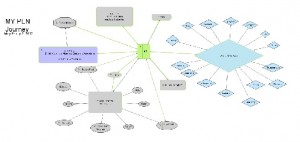In his Introduction to his book, Personal Learning Networks, Will Richardson identifies why networks and connecting are so important for teachers of the 21st century. He explains how today’s learning landscape is vastly different than what we have seen in the past 150+ years. As I read I was reminded of the RSA-Animate where Sir Ken Robinson breaks down what is no longer working in the current education system. (If you haven’t seen it, I highly recommend it. I also encourage you to share it with your students, and their parents. In fact, view it together to create a dialogue about where you want your classroom to go.)
Both Richardson and Robinson agree that the world wide web, and 24 hour access to information, is changing the way we learn, and the process of learning as a whole. Personally, I can attest to this; I see it every day. I have more and more students accessing information on their smartphones than the classroom computers; there are more students asking if they can email me their homework than ever before, a parent told me the other day that she found it strange that I didn’t have a facebook account so she could “connect with me” – her words! At breaks students are hanging out on twitter and tumblr instead of in the yard or the cafeteria. The world it is a changin’! And I for one want to be a part of it.
Richardson is a strong advocate for helping teachers embrace 21 century technologies and all that they have to offer; he believes that teachers and schools need to “plug into this vibrant worldwide network of learning to stay relevant and to prepare our children for a vastly different landscape” (p.3 ).
Below is a short 3 minute video of Richardson discussing the need for teachers to embrace PLNs in this new learning (and teaching) climate.
The 21st century is upon us, and it’s filled with technologies – mobile technologies, technologies to enable communication, technologies to facilitate collaboration, technologies to inspire creativity, and technologies to promote innovation. It is our job to ensure our students acquire the skills essential to success in the 21st century and beyond. As Richardson says in his intro, “teachers need to: stay relevant in order to prepare students for the “vibrant worldwide network of learning” (p.3 ).
In 2010, in my first MET course, ETEC 511, I was introduced to the International Society for Technology in Education’s (ISTE) NETS for students (2012) and NETS for teachers. I highly recommend you check them out. You can even download a pdf version. These short and sweet documents will help you get a better understanding of the skills that are important for today’s students and teachers.
If you want more information on 21st learning skills I highly recommend Bernie Trilling and Charles Fadel’s book, 21st Century Skills: Learning for Life in Our Times. I read this book two years ago and it really helped me bring theory into practice in my classroom. In my opinion it is a must read. (Several libraries have the book available in ebook format as well).
I would also encourage you to check out the Canadian Council on Learning’s 21st Century Learning Initiative ,as well as the United States’ initiative – Partnership for 21st Century Skills. Every province and every school district across the country should have their own version of the 21st century skills available to teachers, and resources to help teachers meet those skills. Here is a link to the British Columbia Teachers Federation (BCTF) site addressing 21st century learning skills.
Be sure to check out your own province’s stance on 21st century skills as well as your school district’s. There should also be a person available in your school or district to help you along the way. And if not, you’ve found me, and together we can start making the essential connections to become effective 21st century educators – relevant educators, educators who are able to turn pedagogy into practice and model the use of learning networks rather than just talking about them.



